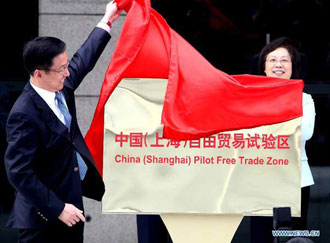The China Pilot Free Trade Zone (Shanghai FTZ) went into effect Sunday as a living laboratory to be used by China’s leadership to test the loosening of the nation’s myriad restrictions that tightly limit the activities of both foreign and Chinese firms.
The Shanghai FTZ is essentially a 29-square-kilometer (11-sq-mi) overlay that covers four existing special trade zones in Shanghai’s newer Pudong district and the airport. The zone is a pet project of Premier Li Keqiang who has pushed it through over determined opposition from conservative Politburo members who fear the zone could lead to a loss of the control the Communist Party is able to exercise over China’s industrial and financial sectors, including the yuan’s permissible range of exchange rates.
“It follows the tendency of global economic developments and reflects a more active strategy of opening-up,” said Commerce minister Gao Hucheng at the ceremony of the zone’s launch.
As part of the opening ceremony 36 companies, including 11 financial firms, were given licenses to operate in the zone. The first company registered in the zone is a game industry joint venture of Microsoft and BesTV — a subsidiary of Shanghai Media Group. The company will be allowed to introduce video game consoles into the FTZ, a first for China which bans such devices outside the zone.
The financial firms given licenses to set up branches in the zone include the Industrial and Commercial Bank of China, Bank of China, Citi (China) and DBS (China). These banks will be first beneficiaries of China’s experiment with full yuan convertibility, interest rates pegged to the market and cross-border use of the yuan, according to the blueprint for the FTZ released by the State Council Friday.
Other service sector businesses that will enjoy relative freedom from China’s cumbersome regulations include the legal profession, business consulting, investments and trade.
While the Shanghai FTZ is touted as being only a laboratory, history suggests it is likely to be more of a spearhead for reforms that China’s new top leadership appears determined to push forward as the only practical way to allow China to continue developing from a low-cost production base into a stable consumer society.
The only real precedent for it is the opening of China’s first special economic zone in Shenzhen in 1980. That so-called experiment quickly became a blueprint for China’s rapid transformation into the world’s manufacturing center and its rise to its current status as the world’s second largest economy. If history is any indicator, the Shanghai FTZ is likely to segue quickly into a similar role for China’s emergence into its almost inevitable new role as the world’s biggest consumer economy.


